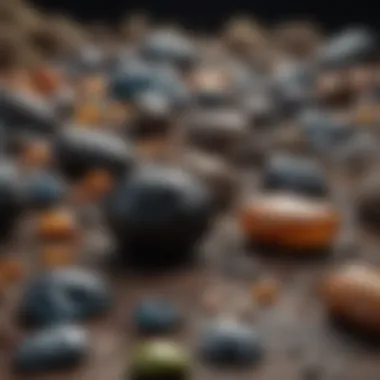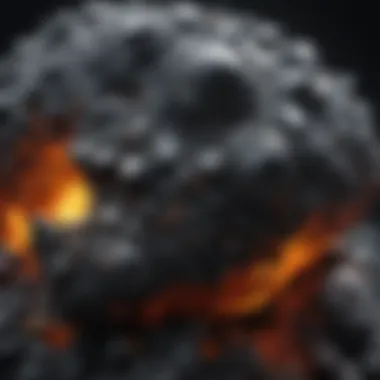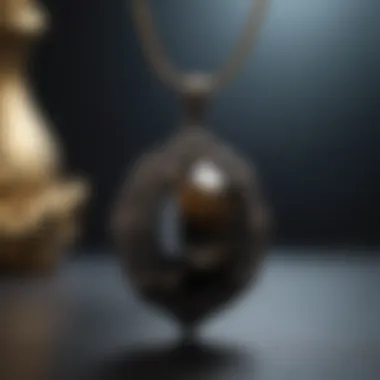Unveiling the Enigmatic World of Tektites: A Detailed Exploration


Rock and Fossil Identification
In the realm of tektites, understanding rock and fossil identification is paramount to discerning the authenticity of these unique natural glass objects. Tektites, rare artifacts formed from meteorite impacts, bear distinctive characteristics that set them apart from traditional rocks and fossils. Key features to look for when identifying tektites include smooth surfaces, unique shapes, and often an iridescent sheen due to their glassy nature. Utilizing tools such as magnifiers and UV lights can aid in the identification process by revealing intricate details that hint at a specimen's origin.
Geological Significance
Delving deeper into the world of tektites unveils a profound geological significance that offers valuable insights into Earth's history and celestial interactions. The geological formations and processes that give rise to tektites shed light on planetary dynamics and the aftermath of meteorite collisions. Beyond their visual appeal, tektites hold historical significance as remnants of extraterrestrial events that have shaped our planet's landscape over millennia. Examining notable discoveries in the field showcases the ongoing exploration and scientific contributions that further our understanding of these enigmatic objects.
Understanding Tektites
In the vast universe of geological marvels, tektites stand out as intriguing and mysterious specimens that captivate the attention of rock and fossil collectors. Understanding tektites is a crucial focal point in this comprehensive guide, as it unveils the enigmatic origins and intricate properties of these rare natural glass objects. By delving into the realm of tektites, enthusiasts can unravel the secrets of their formation, explore their unique composition, and appreciate their significance in scientific and cultural contexts. Through a meticulous examination of tektites, collectors gain valuable insights into the complex interplay between extraterrestrial forces and terrestrial geology.
What are Tektites?
Tektites are enigmatic glassy objects formed by the intense heat and pressure resulting from meteorite impacts on Earth's surface. These intriguing specimens lack a crystalline structure, distinguishing them from typical minerals and gemstones. Tektites exhibit aerodynamic shapes, often resembling droplets or buttons, a testament to their rapid cooling and solidification upon impact. Their intriguing texture and unique composition set them apart from other terrestrial rocks, making them highly sought-after by collectors for their distinctiveness and geological significance.
Formation of Tektites
The formation of tektites is a fascinating process that begins with the impact of a meteorite on Earth. Upon collision, the immense heat generated transforms terrestrial rock and meteorite material into a molten state, creating a glassy mass that is ejected into the atmosphere. As this molten material cools and solidifies during reentry, tektites are formed, bearing the signature characteristics of their extraterrestrial origins. This intricate process of impact, fusion, and ejection results in the unique shapes and compositions that define tektites and make them a source of wonder and fascination for collectors and scientists alike.
Properties of Tektites
Tektites exhibit a fascinating array of properties that set them apart from conventional gemstones and minerals. These natural glasses are typically characterized by their dark, glossy surfaces, often displaying intriguing patterns and textures created during their rapid cooling process. Tektites are known for their low water content and high silica content, a combination that contributes to their unique physical and chemical properties. Additionally, their aerodynamic shapes and lack of a crystalline structure provide further insight into their extraterrestrial origins, making them valuable specimens for study and collection. By exploring the properties of tektites, collectors can uncover the distinctive features that make these enigmatic objects truly one-of-a-kind in the world of geology and mineralogy.
Types of Tektites


Exploring the different types of tektites is a significant component in uncovering the world of these unique natural glass formations. Understanding the distinct characteristics of each type holds paramount importance in both scientific research and collector pursuits. When delving into the realm of tektites, one encounters three primary classifications: Moldavites, Australites, and Indochinites. Each type possesses its own unique features, origins, and desirability, making them intriguing subjects for enthusiasts and researchers alike.
Moldavites
Among the various types of tektites, Moldavites stand out for their distinctive green color and textured surface, originating from the Czech Republic. These tektites are highly sought after by collectors due to their scarcity and appealing aesthetic qualities. Moldavites are believed to have formed from the impact of a meteorite in southern Germany about 15 million years ago, creating a fascinating link to ancient celestial events. Their alluring shade and intriguing shape make Moldavites prized additions to any tektite collection.
Australites
Australites, also known as Australasian tektites, derive their name from their primary source region in Australasia, encompassing areas like Australia, Southeast Asia, and the Indian Ocean. These tektites are recognized for their dark shades of black, brown, or green, paired with aerodynamic forms attributed to their molten nature upon impact. Australites show diversity in their appearance, with subtle variations in texture and color adding to their allure for collectors and researchers interested in the dynamics of meteorite impacts.
Indochinites
Indochinites represent a group of tektites found predominantly in Southeast Asia, particularly in regions like Thailand, Laos, and China. These tektites showcase an intriguing color palette ranging from dark green to black, often with sculpted surfaces that hint at their high-velocity formation. The enigmatic origin of Indochinites, believed to be linked to a meteoritic impact in Southeast Asia around 800,000 years ago, adds to their mystique and scientific significance. Collectors appreciate Indochinites for their striking appearance and the geological insights they offer into ancient cosmic events.
Significance of Tektites
Tektites hold a significant place in the realm of natural phenomena, offering a window into the past and the mysteries of our universe. In this article on Exploring the World of Tektites, their importance transcends mere geological curiosity, delving into their cultural, historical, and scientific significance. As rare products of extraterrestrial impacts, tektites serve as tangible connections to celestial events, sparking intrigue and wonder among enthusiasts and researchers alike.
Cultural and Historical Importance
Tektites have long captured the imagination of various cultures throughout history, often revered as sacred objects imbued with mystical powers. From being used in jewelry and ornaments to symbolic artifacts in rituals and ceremonies, tektites hold a revered status in folklore and traditions worldwide. Their presence in archaeological sites further emphasizes their historical importance, showcasing how past civilizations interacted with these enigmatic glassy gems. Exploring the cultural significance of tektites unveils layers of human fascination with the cosmos and the unique allure of these cosmic gifts.
Scientific Relevance
From a scientific perspective, tektites provide valuable insights into impact events, Earth's formation processes, and even potential extraterrestrial origins. Studying the chemistry, structure, and distribution of tektites contributes to understanding meteorite impacts on our planet and how these events have shaped Earth's geological landscape over millions of years. Additionally, tektites offer a glimpse into the extreme conditions generated during meteorite impacts, shedding light on the transformation of terrestrial materials into glassy objects through intense heat and pressure. The scientific relevance of tektites extends beyond Earth-bound studies, stimulating research on planetary formation and impact dynamics in the broader context of our solar system.
Identifying Genuine Tektites


Identifying genuine tektites is a crucial aspect of this comprehensive guide, aiming to provide readers with the necessary knowledge to discern authentic specimens from counterfeit ones. This section plays a pivotal role in equipping rock and fossil collectors with the expertise needed to make informed purchasing decisions and build a credible collection. By delving into the characteristics of authentic tektites and offering tips for spotting fake ones, readers will gain a deep understanding of the significance of authenticity in the realm of tektites.
Characteristics of Authentic Tektites
Genuine tektites exhibit specific characteristics that differentiate them from artificial or altered counterparts. These natural glass objects typically showcase unique textures, such as aerodynamic shapes and smooth surfaces resulting from their high-velocity ejection from impact craters. Authentic tektites also feature conchoidal fractures, resembling those of natural obsidian, along with distinct colors like olive green or black, reflective of their terrestrial origin.
Tips for Spotting Fake Tektites
Spotting fake tektites requires attention to detail and understanding of common fraudulent practices in the market. One essential tip is to be wary of tektites that lack the typical fusion crust found on genuine specimens, as this coating forms during the intense heat of impact events. Additionally, scrutinizing the presence of bubbles, inconsistencies in texture, or artificial etching can help identify counterfeit tektites. Seeking reputable sellers and obtaining certification for tektite purchases further safeguards collectors against acquiring inauthentic pieces.
Where to Find Tektite for Sale
In the realm of tektites, accessing authentic specimens is crucial for both novice collectors and seasoned enthusiasts. Understanding where to find tektites for sale plays a pivotal role in acquiring genuine pieces. This section delves into the significance of sourcing tektites, addressing specific elements such as authenticity, variety, and reliability.
Online Marketplaces
Online marketplaces serve as treasure troves for tektite hunters, offering a vast array of specimens from various sources worldwide. These platforms provide a convenient avenue for enthusiasts to explore and purchase tektites without geographical constraints. One can find an extensive range of tektites spanning different types and price ranges, catering to collectors with diverse preferences. It is essential to exercise caution and diligence when navigating online marketplaces to ensure the authenticity and quality of tektite specimens.
Specialized Stores
Specialized stores dedicated to geological treasures are ideal destinations for individuals seeking premium tektite specimens. These stores often house curated collections of tektites, each meticulously sourced and authenticated by experts in the field. By visiting specialized stores, collectors can engage with knowledgeable staff who can offer valuable insights and guidance on selecting authentic tektites. The physical browsing experience at specialized stores allows enthusiasts to appreciate the minute details and unique characteristics of tektites up close, enhancing the overall collecting journey.
Factors to Consider When Purchasing Tektites
In the realm of tektites, navigating the process of purchasing these rare natural glass specimens requires careful consideration of various factors to ensure authenticity and value. Understanding the significance of selecting the right tektite is pivotal in expanding one's collection or acquiring a piece of scientific interest. This section will delve into the essential elements that rock and fossil collectors should prioritize when seeking to purchase tektites.
Authenticity and Certification


The cornerstone of any tektite acquisition lies in verifying its authenticity and certification. Genuine tektites possess unique characteristics that differentiate them from regular glass or imitations. Buyers must familiarize themselves with the markings and features that reputable certifying bodies recognize to confirm the validity of the specimen. Certification adds a layer of assurance, indicating that the tektite has undergone scrutiny by experts in the field, enhancing its credibility and value.
Seller Reputation
When delving into the world of purchasing tektites, considering the reputation of the seller is of utmost importance. Reputable sellers with a strong track record of dealing in authentic tektites instill confidence in buyers, mitigating the risk of acquiring counterfeit or misrepresented specimens. Researching the seller's history, reviews, and professional affiliations can provide valuable insights into their credibility and integrity, safeguarding collectors from potential fraudulent transactions.
Price Comparison
The pricing of tektites can vary significantly depending on factors such as rarity, size, and condition. Conducting thorough price comparisons among different sellers and marketplaces ensures that collectors obtain their desired specimens at a fair market value. By assessing pricing trends and understanding the factors influencing tektite prices, buyers can make informed decisions that align with their budget and collection goals. Prioritizing price comparison enables collectors to optimize their purchasing power while maintaining quality standards in their acquisitions.
Tips for Caring for Tektite Specimens
In this comprehensive guide on exploring the world of tektites, it is crucial to discuss the essential topic of caring for tektite specimens. Caring for these unique natural glass objects is not only about preserving their beauty but also maintaining their integrity and value. By understanding the proper care techniques, collectors can ensure the longevity and quality of their tektite specimens.
Storage and Display
Proper storage and display are paramount in preserving the condition of tektite specimens. When storing tektites, it is crucial to keep them away from direct sunlight and extreme temperatures to prevent any damage or discoloration. Choosing suitable display cases or shelves that provide protection from dust and moisture is also essential. By following these storage and display practices, collectors can showcase their tektites while safeguarding them from environmental factors that could potentially harm the specimens.
Cleaning and Maintenance
Cleaning and maintenance play a significant role in caring for tektite specimens. Dust and dirt accumulation can not only affect the appearance of tektites but also impact their clarity and shine. Using a soft, lint-free cloth and mild soap to gently clean tektites is recommended. Additionally, avoid harsh chemicals or abrasive materials that could scratch or damage the surface of the tektite. Regular inspection for any signs of wear or damage is also advised to address any issues promptly and prevent further deterioration. By incorporating proper cleaning and maintenance practices into their routine, collectors can preserve the beauty and authenticity of their tektite specimens for years to come.
Conclusion
The conclusion of this comprehensive guide on tektites serves as a vital component in summarizing the wealth of knowledge imparted throughout the article. As we journeyed through the intricate world of tektites, each section meticulously detailed their origins, properties, types, significance, identification, purchasing considerations, and maintenance tips. The significance of this conclusion lies in its ability to bring together all these key aspects in a cohesive manner, providing a holistic view of tektites for enthusiasts and collectors alike.
One of the primary benefits of this conclusion is its role in reinforcing the importance of understanding tektites as rare natural specimens with a rich history rooted in meteorite impacts. By consolidating the information presented in previous sections, the conclusion acts as a synthesis of knowledge, offering readers a complete picture of tektites' allure and scientific value.
Furthermore, the conclusion underscores the practical implications of the guide, from aiding in the identification of authentic tektites to guiding potential buyers on where to find genuine specimens. It emphasizes the importance of careful consideration when purchasing tektites, highlighting key factors such as authenticity, certification, seller reputation, and pricing comparisons.
Moreover, the conclusion encapsulates the essence of caring for tektite specimens, stressing the significance of proper storage, display, cleaning, and maintenance to preserve their integrity and beauty. It serves as a reminder of the responsibility that comes with owning these unique treasures from the cosmos.
In essence, this conclusion acts as a culmination of insights, recommendations, and valuable information garnered from each section, rounding off the comprehensive guide with a cohesive narrative that aims to educate, inspire, and deepen the readers' appreciation for the enchanting world of tektites.







